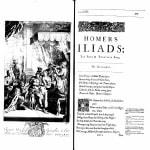
Engraving after Abraham van Diepenbeeck, King Priam visiting Achilles, in: John Ogilby,
Homer his Iliads / translated, adorn'd with sculpture, and illustrated with annotations, London, 1669.
Abraham van Diepenbeeck ('s-Hertogenbosch 1596 - 1675 Antwerp)
Abraham van Diepenbeeck was born in ‘s-Hertogenbosch in 1596. He was first taught by his father, Jan Roelofsz. van Diepenbeeck, who was a glass painter. Abraham was first recorded in 1622 as a glass painter in the Antwerp guild. He was further trained by a certain Abraham van Lamoen (a still life painter about whom we otherwise known little to nothing). It has been hotly debated whether or not he was also trained by Rubens; it is however certain that they collaborated on several projects. (For instance, the print for the title page of Torniello’s Annales Sacri was signed by Rubens as well as by van Diepenbeeck.) It would not be inaccurate to state that van Diepenbeeck was an assistant to Rubens of sorts. In 1636 he was registered as a poorter – citizen – of Antwerp; in 1638 he became a member of the local Guild of St Luke.
In the 1620’s he was mainly active as a designer of prints for books, stained-glass windows and tapestries; it was only later on that he would focus on painting. Van Diepenbeeck travelled to Great Britain in 1629; in 1632 he went to Paris and Fontainebleau, on assignment for Rubens. His collaboration with Rubens however did not prevent him from undertaking independent projects as a painter and engraver as well. While in England during the reign of Charles I, for instance, he painted several portraits, including that of the 1st Duke of Newcastle; he also illustrated the latter’s book on horsemanship.
Our drawing is a fine testament to van Diepenbeeck's draughtsmanship. We see Priam, king of the Trojans, who has snuck into Achilles' tent to beg him to return the body of his son Hector, so he can be properly buried. Moved by the old man's tears and impressed by his courage, Achilles duly returns Hector's body to his grieving father. Executed on blue laid paper, the drawing has been incised for transfer, indicating that the image was engraved. Recently it was found that the present work is in fact a design for an illustration for the 1669 edition of John Ogilby's new translation of the Iliad, Homer his Iliads / translated, adorn'd with sculpture, and illustrated with annotations, which was first published in London in 1660 (see image).
Provenance
Private collection, France.
Literature
S. van Altena, '"Rubens's most truthful follower": Abraham van Diepenbeeck as a Draftsman', Master Drawings, vol. 58, no. 4 (Winter 2020), p. 503, fig. 15.- X
- Tumblr
-
 Abraham van Diepenbeeck ('S-HERTOGENBOSCH 1596 - 1675 ANTWERPEN)A Design for the Print "Pax Optima Rerum"pen and brown ink, brush and grey wash, over traces of black chalk on laid paper116 x 155 mmsigned 'AVD', lower right
Abraham van Diepenbeeck ('S-HERTOGENBOSCH 1596 - 1675 ANTWERPEN)A Design for the Print "Pax Optima Rerum"pen and brown ink, brush and grey wash, over traces of black chalk on laid paper116 x 155 mmsigned 'AVD', lower right -
 Abraham van Diepenbeeck ('s-Hertogenbosch 1596 - 1675 Antwerp)The Assumption of the Virginblack chalk, pen and brown ink on laid paper170 x 140 mm
Abraham van Diepenbeeck ('s-Hertogenbosch 1596 - 1675 Antwerp)The Assumption of the Virginblack chalk, pen and brown ink on laid paper170 x 140 mm -
 Abraham van Diepenbeeck ('s-Hertogenbosch 1596 - 1675 Antwerp)The Adoration of the Shepherdspen and brown ink over black chalk109 x 84 mm
Abraham van Diepenbeeck ('s-Hertogenbosch 1596 - 1675 Antwerp)The Adoration of the Shepherdspen and brown ink over black chalk109 x 84 mm





